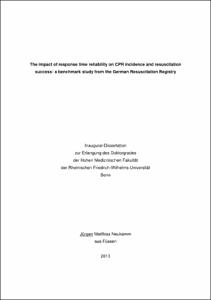The impact of response time reliability on CPR incidence and resuscitation successa benchmark study from the German Resuscitation Registry

The impact of response time reliability on CPR incidence and resuscitation success
a benchmark study from the German Resuscitation Registry

| dc.contributor.advisor | Fischer, Matthias | |
| dc.contributor.author | Neukamm, Jürgen Matthias | |
| dc.date.accessioned | 2020-04-18T06:32:24Z | |
| dc.date.available | 2020-04-18T06:32:24Z | |
| dc.date.issued | 23.07.2013 | |
| dc.identifier.uri | https://hdl.handle.net/20.500.11811/5445 | |
| dc.description.abstract | Sudden cardiac arrest is one of the most frequent causes of death in the world. In highly qualified EMS systems, including well trained emergency physicians, spontaneous circulation may be restored in up to 53% of patients at least until admission to hospital. Compared with these highly qualified EMS systems, in other systems markedly lower success rates are observed. These data clearly show that there are considerable differences between EMS systems concerning treatment success following cardiac arrest and resuscitation, although in all systems international guidelines for resuscitation are used. This study compares 7 German EMS systems participating in the German Resuscitation Registry. The influence of response time reliability on CPR incidence and resuscitation success is analysed. Anonymized patient data after out of hospital cardiac arrest from 2006 to 2009 of 7 EMS systems in Germany were analysed to socioeconomic factors (population, area, EMS unit hours), process quality (response time reliability, CPR incidence, special CPR measures, prehospital cooling), patient factors (age, gender, cause of cardiac arrest, bystander CPR). Endpoints were defined as ROSC, admission to hospital, 24h survival and hospital discharge rate. For statistical analyses, chi-square, t-test and Bonferroni correction were used. 2,330 prehospital CPR from 7 centres were included in this analysis. Incidence of sudden cardiac arrest differs from 36.0 to 65.1 / 100,000 inhabitants / year. We identified two EMS systems reaching the patients within 8 min in 62.0 and 65.6% while the other five EMS systems achieved 70.4 up to 95.5%. EMS systems arriving relatively later at the patients side (RTR<70%) less frequently initiate CPR and admit fewer patients alive to hospital (calculated per 100,000 inhabitants / year). Using the multi-variate RACA score to predict outcome, the percentage ROSC rate in all 7 centres were higher than predicted. This study demonstrates that on the level of EMS systems, faster ones will more often initiate CPR and will increase number of patients admitted alive to hospital. Furthermore it is shown that with very different approaches, all adhering to and intensely training in the ERC guidelines 2005, superior and, according to international comparison, excellent success rates following resuscitation may be achieved. | en |
| dc.language.iso | eng | |
| dc.rights | In Copyright | |
| dc.rights.uri | http://rightsstatements.org/vocab/InC/1.0/ | |
| dc.subject | Reanimation | |
| dc.subject | Herzstillstand | |
| dc.subject | Reanimationsregister | |
| dc.subject | Rettungsdienst | |
| dc.subject | Hilfsfrist | |
| dc.subject | Resuscitation | |
| dc.subject | cardiac arrest | |
| dc.subject | resuscitation registry | |
| dc.subject | EMS system | |
| dc.subject | response time reliability | |
| dc.subject.ddc | 610 Medizin, Gesundheit | |
| dc.title | The impact of response time reliability on CPR incidence and resuscitation success | |
| dc.title.alternative | a benchmark study from the German Resuscitation Registry | |
| dc.type | Dissertation oder Habilitation | |
| dc.publisher.name | Universitäts- und Landesbibliothek Bonn | |
| dc.publisher.location | Bonn | |
| dc.rights.accessRights | openAccess | |
| dc.identifier.urn | https://nbn-resolving.org/urn:nbn:de:hbz:5n-31109 | |
| ulbbn.pubtype | Erstveröffentlichung | |
| ulbbnediss.affiliation.name | Rheinische Friedrich-Wilhelms-Universität Bonn | |
| ulbbnediss.affiliation.location | Bonn | |
| ulbbnediss.thesis.level | Dissertation | |
| ulbbnediss.dissID | 3110 | |
| ulbbnediss.date.accepted | 10.01.2013 | |
| ulbbnediss.fakultaet | Medizinische Fakultät | |
| dc.contributor.coReferee | Putensen, Christian |
Files in this item
This item appears in the following Collection(s)
-
E-Dissertationen (1998)




